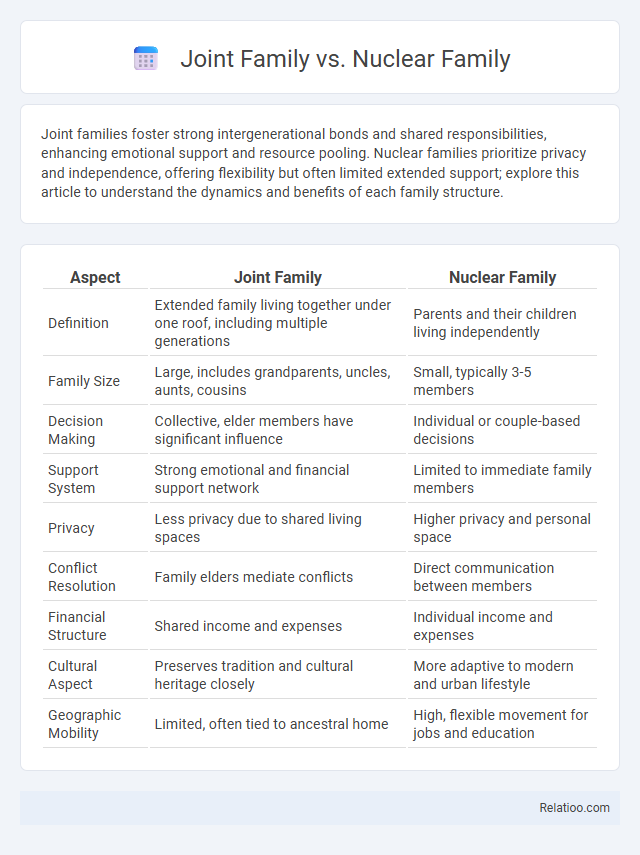Joint families foster strong intergenerational bonds and shared responsibilities, enhancing emotional support and resource pooling. Nuclear families prioritize privacy and independence, offering flexibility but often limited extended support; explore this article to understand the dynamics and benefits of each family structure.
Table of Comparison
| Aspect | Joint Family | Nuclear Family |
|---|---|---|
| Definition | Extended family living together under one roof, including multiple generations | Parents and their children living independently |
| Family Size | Large, includes grandparents, uncles, aunts, cousins | Small, typically 3-5 members |
| Decision Making | Collective, elder members have significant influence | Individual or couple-based decisions |
| Support System | Strong emotional and financial support network | Limited to immediate family members |
| Privacy | Less privacy due to shared living spaces | Higher privacy and personal space |
| Conflict Resolution | Family elders mediate conflicts | Direct communication between members |
| Financial Structure | Shared income and expenses | Individual income and expenses |
| Cultural Aspect | Preserves tradition and cultural heritage closely | More adaptive to modern and urban lifestyle |
| Geographic Mobility | Limited, often tied to ancestral home | High, flexible movement for jobs and education |
Introduction to Family Structures
Family structures vary widely, with joint families comprising extended relatives living together under one roof, promoting shared responsibilities and collective decision-making. Nuclear families consist of two parents and their children, emphasizing individual privacy and autonomy while facilitating mobility and economic independence. Customary family arrangements often reflect cultural traditions that influence roles, relationships, and social expectations within both joint and nuclear family frameworks.
Definition of Joint Family
A joint family is defined as an extended family arrangement where multiple generations live together under one roof, sharing resources and responsibilities, often including grandparents, parents, children, and sometimes uncles and aunts. This family structure fosters strong emotional bonds and collective decision-making, contrasting with nuclear families, which consist of only parents and their children living independently. Your choice between joint and nuclear family arrangements impacts social dynamics, privacy, and cultural practices rooted in family customs.
Definition of Nuclear Family
A nuclear family consists of two parents and their children living together as a single household unit, emphasizing a more compact and independent family structure. Unlike joint families, which include multiple generations and extended relatives under one roof, nuclear families prioritize privacy and individual decision-making. Customs within nuclear families often adapt to contemporary social norms, reflecting changes in family roles and responsibilities.
Historical Evolution of Family Types
The historical evolution of family types reveals distinct shifts from joint families--which featured extended kinship networks sharing resources and responsibilities--toward nuclear families emphasizing individualism and autonomy. Customs deeply influenced these transitions, with cultural norms historically favoring joint families in agrarian societies for economic cooperation, whereas modernization and urbanization advanced nuclear family structures in industrialized contexts. Understanding your family dynamics benefits from recognizing how these evolutionary patterns reflect socioeconomic changes and cultural adaptations over time.
Social Dynamics in Joint Families
Joint families foster strong social dynamics through close-knit relationships, shared responsibilities, and collective decision-making, creating a supportive environment that contrasts with the independence seen in nuclear families. The social fabric in joint families encourages cooperation, emotional bonding, and conflict resolution skills, benefiting your overall social development. Customary practices within joint families further reinforce cultural values and intergenerational ties, enhancing social cohesion and stability.
Privacy and Independence in Nuclear Families
Nuclear families prioritize privacy and independence by limiting household members to immediate family, which fosters personal space and decision-making autonomy. This contrasts with joint families, where multiple generations cohabit, often resulting in shared responsibilities and reduced individual privacy. Customs in nuclear families typically emphasize self-reliance and individualized lifestyle choices, enhancing personal freedom compared to the collective nature of joint family living.
Economic Implications: Joint vs Nuclear
Joint families often benefit from shared resources, lower per capita living expenses, and collective financial support, which can lead to greater economic stability and resilience. In contrast, nuclear families typically face higher individual costs for housing, childcare, and utilities, demanding more independent financial management and savings strategies. Understanding these economic implications helps you evaluate which family structure aligns better with your financial goals and lifestyle preferences.
Child Development and Family Environment
Joint families provide children with a rich social environment and diverse role models, fostering strong emotional support and cultural values, while nuclear families often offer more privacy and focused parental attention, enhancing personalized child development. Customary family practices influence how children learn social norms, discipline, and responsibilities, shaping their behavior and emotional well-being within both joint and nuclear settings. Your child's development is deeply affected by the interaction between family structure and cultural customs, impacting their social skills, resilience, and sense of identity.
Challenges Faced by Each Family Type
Joint families face challenges in maintaining privacy and managing conflicting opinions due to shared living spaces and intergenerational dynamics. Nuclear families often struggle with limited support systems, which can lead to increased stress in balancing work-life responsibilities and childcare. Your ability to preserve cultural customs may be tested differently in each family type, as joint families uphold traditional values collectively, while nuclear families may find it harder to sustain certain customs without extended family involvement.
Future Trends in Family Systems
Future trends in family systems indicate a shift towards nuclear families due to urbanization, economic factors, and increased mobility, which emphasize individual autonomy and privacy. Joint families continue to persist in regions prioritizing cultural heritage and collective support, but their prevalence is declining as younger generations seek independence. Understanding these dynamics helps you anticipate changes in social support structures and caregiving responsibilities in your community.

Infographic: Joint Family vs Nuclear Family
 relatioo.com
relatioo.com